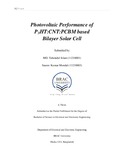| dc.contributor.advisor | Mominuzzaman, Dr. Sharif Mohammad | |
| dc.contributor.author | Islam, MD. Tahmidul | |
| dc.contributor.author | Mondal, Saurav Kumar | |
| dc.date.accessioned | 2016-10-25T04:07:36Z | |
| dc.date.available | 2016-10-25T04:07:36Z | |
| dc.date.copyright | 2016 | |
| dc.date.issued | 2016-04 | |
| dc.identifier.issn | ID 11210003 | |
| dc.identifier.other | ID 11210001 | |
| dc.identifier.uri | http://hdl.handle.net/10361/6630 | |
| dc.description | This thesis report is submitted in partial fulfillment of the requirements for the degree of Bachelor of Science in Electrical and Electronic Engineering, 2016. | en_US |
| dc.description | Cataloged from PDF version of thesis report. | |
| dc.description | Includes bibliographical references (page 75-81). | |
| dc.description.abstract | Organicbilayer solarcells have the potential to replace silicon based solar cell devices due to its low cost fabrication cost and high mechanical flexibility. However, despite possessing such remarkable properties their application in the main stream market hasn’t beenfeasible enough due to its low PCE. The efficiency of bilayer heterojunction solar cell is limited mainly due to the low hole mobility of the polymer and the low UV region absorptivity of the active composite. The primary reason for the low PCE of bilayer organic solar cell is its low carrier mobility which is hindered by the hopping transport mechanism of the organic active layer.CNTs are known to have high carrier mobility due its ballistic property and can also absorb photon wavelengths in the infra-red region. This exciting optical and electrical property of CNTs makes them a promising material as an additive to Polymer: Fullerene based bilayer OSCs. In this thesis we examine the impact of CNT on the J-V characteristics of P3HT: PCBM based bilayerheterojunction solar cell. The optical and electrical simulationof the bilayerheterojunction solar cell was carried out using the simulation tool OPV lab which uses the optical transfer matrix methodology to determine the optical properties of the organic active layer. The tool also numerically solves the 1D drift-diffusion equation to predict the J-V characteristics of the organic photovoltaic deviceThe result obtained from the J-V curve show that the photovoltaic performance of the P3HT:PCBM solar cell devices depend on the concentration of CNT. The incorporation of the 1% CNT improved the Jsc by 10%. The Voc at 1weight percentageCNT remained relatively same as the reference devices while the power conversion efficiency enhanced by 34% | en_US |
| dc.description.statementofresponsibility | MD. Tahmidul Islam | |
| dc.description.statementofresponsibility | Saurav Kumar Mondal | |
| dc.format.extent | 81 pages | |
| dc.language.iso | en | en_US |
| dc.publisher | BRAC University | en_US |
| dc.rights | BRAC University thesis are protected by copyright. They may be viewed from this source for any purpose, but reproduction or distribution in any format is prohibited without written permission. | |
| dc.subject | Photovoltaic performance | en_US |
| dc.subject | Solar cell | en_US |
| dc.subject | Renewable energy | en_US |
| dc.subject | Circuit | en_US |
| dc.title | Photovoltaic performance of P3HT:CNT:PCBM based bilayer solar cell | en_US |
| dc.type | Thesis | en_US |
| dc.contributor.department | Department of Electrical and Electronic Engineering, BRAC University | |
| dc.description.degree | B. Electrical and Electronic Engineering | |

